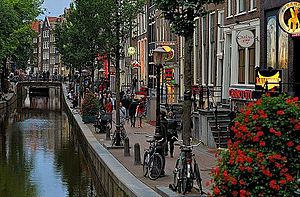A red-light district or pleasure district is a part of an urban area where a concentration of prostitution and sex-oriented businesses, such as sex shops, strip clubs, and adult theaters, are found. In most cases, red-light districts are particularly associated with female street prostitution, though in some cities, these areas may coincide with spaces of male prostitution and gay venues.[1] Areas in many big cities around the world have acquired an international reputation as red-light districts.[2]

Origins of the term
editRed-light districts are mentioned in the 1882 minutes of a Woman's Christian Temperance Union meeting in the United States.[3] The Oxford English Dictionary records the earliest known appearance of the term "red light district" in print as an 1894 article from the Sandusky Register, a newspaper in Sandusky, Ohio.[citation needed]
Author Paul Wellman suggests that this and other terms associated with the American Old West originated in Dodge City, Kansas, home to a well-known prostitution district during the 19th century, which included the Red Light House saloon.[4] This has not been proven, but the Dodge City use was likely responsible for the term's pervasiveness.[5] A widespread folk etymology claims that early railroad workers took red lanterns with them when they visited brothels so their crew could find them in the event of an emergency. However, folklorist Barbara Mikkelson regards this as unfounded.[6]
A more plausible explanation might originate from the time when sailors came back from sea to Amsterdam (c. 1650): Women working as prostitutes, deprived of proper hygiene and running fresh water, carrying red lanterns — with their color camouflaging boils, zits, inequalities in the face and on the skin — made clear they were available as women of pleasure. Sailors, finally getting their relative royal pay, having been at sea for quite some time and looking for relief could so easily spot who would be available. In a later stage, the red lanterns evolved into red lights at brothels. Since this was close to the main harbor, this district became known as the red-light district:
One of the many terms used for a red-light district in Japanese is akasen (赤線), literally meaning "red-line". Japanese police drew a red line on maps to indicate the boundaries of legal red-light districts. In Japanese, the term aosen (青線), literally meaning "blue-line", also exists, indicating an illegal district.
In the United States during the 19th and early 20th centuries, the term "sporting district" became popular for legal red-light districts. Municipal governments typically defined such districts explicitly to contain and regulate prostitution.[7]
Other uses
editIn WWI (circa 1915), "Brothels displayed blue lamps if they were for officers and red lamps for other ranks."[8]
Legal issues
editSome red-light districts (such as De Wallen, Netherlands, or Reeperbahn, Germany) are places that are officially designated by authorities for legal and regulated prostitution.[2] Often, these red-light districts were formed by authorities to help regulate prostitution and other related activities, such that they were confined to a single area.[9]
Some red-light districts (such as those in The Hague)[10] are under video surveillance. This can help counter illegal forms of prostitution (such as child prostitution), in these areas that do allow regular prostitution to occur.
Image gallery
edit-
The Red Light District in Amsterdam
-
Rooms illuminated by red lights in De Wallen, Amsterdam, Netherlands
See also
editReferences
edit- ^ Caves, R. W. (2004). Encyclopedia of the City. Routledge. pp. 559. ISBN 9780415252256.
- ^ a b "History of the Red light District « What you should know about Amsterdam". Whatyoushouldknowaboutamsterdam.WordPress .com. 2009-08-27. Retrieved 2012-09-01.
- ^ Minutes of the Ninth Annual Meeting. National Woman's Christian Temperance Union. 1882. pp. 332, 333 & 363.
- ^ Wellman, Paul Iselin (1988). The Trampling Herd: The Story of the Cattle Range in America. University of Nebraska Press. p. 195. ISBN 0-8032-9723-8.
Paul Wellman Dodge City red light.
- ^ Barra, Allen (2009). Inventing Wyatt Earp: His Life and Many Legends. University of Nebraska Press. ISBN 978-0803220584.
- ^ Barbara Mikkelson (July 9, 2007). "Red Light District". snopes.com. Retrieved October 3, 2010.
- ^ Woolston, Howard Brown (1921). Prostitution in the United States. New York: The Century Company. p. 105–107. ISBN 978-0-217-03857-7.
- ^ "WW1 brothels: Why troops ignored calls to resist 'temptation'". British Broadcasting Corporation (BBC). 2014-02-27. Retrieved 2024-04-26.
{{cite web}}: CS1 maint: date and year (link) - ^ "The Red Light District of Amsterdam". CamsterDamn. Archived from the original on May 20, 2013. Retrieved February 20, 2013.
- ^ "Camera surveillance in red-light districts in The Hague". January 24, 2014. Archived from the original on 2016-10-08.
External links
editMedia related to Red-light districts at Wikimedia Commons